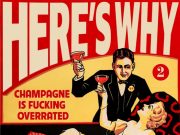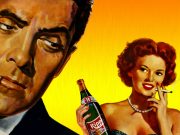Is absinthe as dangerous as they say, and where can I get some?
Dangerous is a relative word. Yes, absinthe is made with wormwood, which contains a psychoactive chemical called thujon, which causes mild hallucinations. If you eat enough wormwood it’ll kill you, but that is true of most vitamins as well. Any fan of the Lost Generation authors or turn of the century French painters knows absinthe was a considered a powerful creative tool. Hemingway, Fitzgerald, Van Gogh, Picasso and others swore by it as a source of inspiration and not a bad way to spend an evening.
So why is it illegal in the US and most other countries? Hysteria. It was scapegoated just before Prohibition took hold of the United States, its detractors claimed it caused insanity, blindness and even death. Most experts now agree that the absinthe didn’t contain enough wormwood to kill anyone and most likely it was the alcohol to blame (it ran about 150 proof back then).
Things are turning around, however; in addition to the Czech Republic, Spain and Portugal, the green faerie is now available in England and British Columbia as well. As for getting some for your own, uh, scientific experiments, there are a few outlaw distillers in town who produce bootleg absinthe. Unfortunately it’s generally the “steeped” variety as opposed to properly distilled absinthe. Fortunately, you can buy the real stuff with a credit card for surprisingly reasonable prices over the web, and they will ship it through U.S, customs in the guise of cooking sherry. One of the better sites is www.laboheme.uk.com. Stay tuned for an upcoming Modern Drunkard review of the mysterious green faerie.
Does alcohol affect races differently?
 Yes. Genetics and physiology play a key role in what effect alcohol has on an individual and different races metabolize alcohol at different rates. The differences are most prominent in some Asian subpopulations, where a large percentage experience flushing of the skin, nausea, headache, and other uncomfortable symptoms from drinking a single alcoholic beverage. Those symptoms result primarily from inactivity of aldehyde dehydrogenase-2 (ALDH2), an enzyme involved in a key step of alcohol metabolism. You have to hand it to the Japanese though, despite all that they remain one of the hardest drinking countries in the world.
Yes. Genetics and physiology play a key role in what effect alcohol has on an individual and different races metabolize alcohol at different rates. The differences are most prominent in some Asian subpopulations, where a large percentage experience flushing of the skin, nausea, headache, and other uncomfortable symptoms from drinking a single alcoholic beverage. Those symptoms result primarily from inactivity of aldehyde dehydrogenase-2 (ALDH2), an enzyme involved in a key step of alcohol metabolism. You have to hand it to the Japanese though, despite all that they remain one of the hardest drinking countries in the world.
Why the differences? Long term exposure to alcohol, the doctors figure. Europeans have been swilling the stuff so long their bodies adapted. The good news for asians is, every generation exposed to alcohol is less likely to come equipped those with those treacherous and lazy enzymes.
Is expensive wine really that much better than the cheap stuff?
 In a word, no. It’s all about what you like. If you prefer the taste of Julio Gallo to Chateau Rothschild, that’s you and your palette’s business. As for those wine experts who would tell you differently, consider this: recently a group of wine experts were gathered together by a German magazine and secretly subjected to a series of experiments. First, the magazine used a tasteless food die to color a white wine red. Most of the experts praised the doctored white as an excellent red. In a second test, the experts sang the praises a cheap wine that had been poured into an expensive-looking bottle, calling it ‘marvellous, ‘forward but charming’ and ‘robust’. When the same cheap vino was served in its original bottle, they condemned it as ‘thin’, ‘weak,’ and ‘too light.’ In other words, the world’s so-called wine experts are a gang of frauds in the employ of the wine industry. Stick with the Gallo.
In a word, no. It’s all about what you like. If you prefer the taste of Julio Gallo to Chateau Rothschild, that’s you and your palette’s business. As for those wine experts who would tell you differently, consider this: recently a group of wine experts were gathered together by a German magazine and secretly subjected to a series of experiments. First, the magazine used a tasteless food die to color a white wine red. Most of the experts praised the doctored white as an excellent red. In a second test, the experts sang the praises a cheap wine that had been poured into an expensive-looking bottle, calling it ‘marvellous, ‘forward but charming’ and ‘robust’. When the same cheap vino was served in its original bottle, they condemned it as ‘thin’, ‘weak,’ and ‘too light.’ In other words, the world’s so-called wine experts are a gang of frauds in the employ of the wine industry. Stick with the Gallo.
Why do girls look more attractive when I’m hammered?
You are undoubtedly speaking of the beer goggle phenomena. To understand how the Rosie O’Donnel at the next table turned into Rosie Perez, you need to grasp what alcohol does to the brain. After that first drink, strange things start to happen in the noggin, namely:
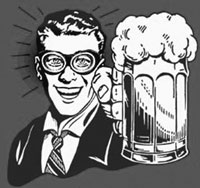 1.) Dopamine concentration is increased, stimulating the pleasure centers.
1.) Dopamine concentration is increased, stimulating the pleasure centers.
2.) Serotonin neurotransmission is decreased. Serotonin is a behavioral inhibitor, it’s the brain’s chemical cop, making you bite your tongue and nod when you actually want to strangle your boss.
3.) Endorphin and enkephalins are released, creating a euphoric effect.
4.) GABA receptors are potentiated, creating an arousal state.
So, after about your fifth drink you will be be feeling euphoric, aroused and uninhibited. You feel confident, your self-esteem is riding high and you not only desire human companionship, you believe you deserve it. Ask any psychologist and he will tell you those with high self-esteem tend to think positively of others as well. And that, in addition to your reduced inhibitions (i.e. standards), is why you go home with Perez and wake up with O’Donnel.
Oddly, the beer goggle theorem doesn’t apply equally to both sexes. In a recent study, 46% of men said alcohol makes women appear sexier, but only 13% of women said the same of men.
Huh. Maybe they’re just not drinking enough. Which brings up the next mystery.
Why do women seem to get drunk faster than men?
It’s all about biology, baby. While there are women who can hold their own with the boys, the fact of the matter is, after consuming the same amount of alcohol, women will have a higher blood alcohol content than men, even when you allow for size differences.
Why? Because women tend to have proportionately more fat and less water in their bodies. Once alcohol gets into your system, it dissipates into your tissue, which is mostly water, as opposed to fat, which is mostly, uh, fat. And the less water you have, the more the booze concentrates. Recent studies have also revealed that alcohol dehydrogenase (an enzyme responsible for the breakdown of alcohol in the body) is found in smaller quantities in women.
Sorry, ladies. It’s not your fault. It’s your parent’s fault.
Why do they say I’m 86’d? Why not 77’d or 33’d?
Well, according to one theory it’s because they don’t want to see your face for the full eighty-six years, and are afraid you might still be alive in thirty-three. Others will tell you it’s rhyming slang for nix.
The most likely reason is the number 86 used to be verbal shorthand at restaurants for being out of something, as in, “Eighty-six the cabbage pancakes,” and was later applied to customers who were plain out of luck.
If that explanation sticks in your craw like a cabbage pancake, here are a couple more possibilities:
A standard crew on British merchant ships in the 19th century was eighty-five, meaning the eighty-sixth sailor was left on shore with the land-lubbers.
There were 85 tables at New York’s famous Twenty-One club. To be offered a seat at “table 86” meant you were about to get tossed out.
A grave is generally eight feet long and six feet deep.
Back in the Old West, 86-proof whiskey was considered weak and strictly for the ladies, so to serve it to a man was a subtle way of saying, “You ain’t wanted ’round here, pard.”
Run that last one by the bouncer the next time he grabs hold of your neck.
Why is it when I travel from Denver to sea level I can drink like a fish and not feel drunk?
It’s all about oxygen. As any physician will tell you, the higher the altitude, the more effect alcohol has on your system. They estimate two drinks at sea level are the equivalent of three to four drinks in Denver, which explains what John Denver was talking about in “Rocky Mountain High.”
It’s a hell of a deal for us high-altitude dwellers, but why are we so deserving? Here’s how—your body needs oxygen to metabolize alcohol. Your liver combines oxygen with alcohol to produce water and CO2, thus ridding the evil liquid from your system. At higher attitudes, where the air is thinner and oxygen less readily available, the unmetabolized alcohol takes another lap around your bloodstream, letting you enjoy the full effects one more time.
And if that is true, you think, the inverse must be true as well, right? Yes, it is. All this time when we thought we were just lolly-gagging around the bars of Denver, we were in actuality in training to become the finest drinking athletes humanity has ever produced.
Just as athletes train at high attitudes to increase their bodies’ oxygen usage efficiency, so have we. The per capita drinking rate of Colorado (we rank 10th) is less than our lower-altitude peers only because, due to the altitude, it takes less to get us drunk. But when we slide down to their sea-level bars, our oxygen-efficient systems allows us to metabolize alcohol much faster, which is why some Denverites find it a Herculean task to get drunk at lower attitudes.
So, if you’re planning on getting hammered in New Orleans, you might want to take out a loan.
Why do the bubbles in a pint of Guinness go down instead of up, like in normal beers?
It took a high-powered industrial computer in Australia to solve the mystery that has haunted shiftless drunks for decades. Here’s what’s happening: the bubbles in Guinness are primarily 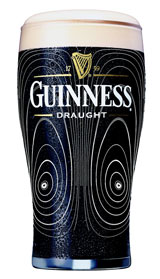 nitrogen, as opposed to the run of the mill CO2 bubbles found in your average lager. Nitrogen bubbles tend to be smaller and tougher, which is why Guinness has such a smooth, long-lasting head. There are bubbles rising in your pint of Guinness, but they’re in the center of the glass and the stout’s natural opacity prevents you from seeing them. As these bubbles rise they drag liquid with them, creating an upward current in the center of the pint, sort of like an erupting volcano. Once the liquid and bubbles reach the top they have no place to go, so the bubbles that are presently unwilling to join the head drag the liquid back down down the inner walls of the glass, creating the cascade of descending bubbles you so enjoy watching. This dynamic cycle continues until all the bubbles decide that, yes, they would like to become part of the head, and you’re left with the classic two-tone Guinness.
nitrogen, as opposed to the run of the mill CO2 bubbles found in your average lager. Nitrogen bubbles tend to be smaller and tougher, which is why Guinness has such a smooth, long-lasting head. There are bubbles rising in your pint of Guinness, but they’re in the center of the glass and the stout’s natural opacity prevents you from seeing them. As these bubbles rise they drag liquid with them, creating an upward current in the center of the pint, sort of like an erupting volcano. Once the liquid and bubbles reach the top they have no place to go, so the bubbles that are presently unwilling to join the head drag the liquid back down down the inner walls of the glass, creating the cascade of descending bubbles you so enjoy watching. This dynamic cycle continues until all the bubbles decide that, yes, they would like to become part of the head, and you’re left with the classic two-tone Guinness.
Fine, you say, but why doesn’t this phenomena occur in a normal beer? Because when the larger and less tough CO2 bubbles reach the surface they simply explode, releasing their CO2 into the air.
Which makes one wonder, why would anyone want to drink some crappy, boring Bud Light when they could be sucking on a science project?
What’s with the worm in some bottles of mescal?
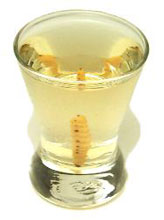 You could listen to the distilleries’ propaganda machine and believe they started putting the worm in to test if the mescal was fully distilled. If the worm died, it was the proper proof, if it started doing the back stroke while singing La Cucaracha, it needed a little more time in the vat.
You could listen to the distilleries’ propaganda machine and believe they started putting the worm in to test if the mescal was fully distilled. If the worm died, it was the proper proof, if it started doing the back stroke while singing La Cucaracha, it needed a little more time in the vat.
The only problem with that story is they didn’t start putting the worm in the mescal until 1950, when they had much more scientific ways of testing if a liquor was up to par. Fact of the matter is, the whole worm/mescal deal was a marketing gimmick thought up by a clever mescal bottler by the name of Jacobo Lozano Paez. The worm (actually a moth larva) is commonly found in the agave plant from which mescal is created, and since a lot of them found their way into mash anyway, Jacobo figured: why not be up front about it and put it right in the bottle?
The gimmick has worked so well they’re starting to run out of good worms, if you can believe it. The true agave worm is red (it will fade to pink in the bottle), but due to the shortage, some distillers are using a white worm, much to the chagrin of mescal purists. Seems they believe the red worm adds much more character and taste than the vastly inferior white worm. Some firebrand distillers have resorted to using plastic worms and, yes, scorpions. Both of which, I’m certain, do wonders for the taste and character.
As far as the worm containing hallucinogenic properties . . . uh, no. That’s just the mescal.
Why do people tap the bar with their glass before drinking a shot? And why do they seem so smug while they’re doing it?
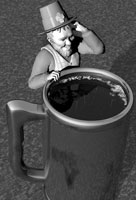 Because they’re cool, dude! Don’t you wanna be cool? Just a little?
Because they’re cool, dude! Don’t you wanna be cool? Just a little?
No, really, it’s most likely a bar version of the ancient “knock on wood” tradition. Historians trace that superstition to three possible origins:
1.) In Old England, if you made an inadvertent boast you would tap on wood and turn your thoughts to the Lord, so you wouldn’t be punished for being a conceited bastard. The idea being, the wood represented the Holy Cross. And let’s face it, most toasts are are an extravagant form of boast.
2.) Celtic druids believed good spirits resided in trees and if you were in danger from evil you could summon a spiritual defender by rapping on a tree trunk. I’m not so sure about this one, because whenever I rap on wood to get the bartender to summon me some good spirits, he usually makes a nasty face at me.
3.) Finally, ancient Irish lore claims knocking on wood is a way of thanking the leprechauns for whatever good luck you may possess. So take your choice: you’re either drinking with Jesus, summoning good spirits or thanking the leprechauns for the beer in your mit.
Why can I slam five whiskies and feel fine, but if I drink three glasses of champagne I turn into an blithering idiot?
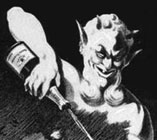 Blame the bubbles, buddy. The old saw that champagne goes right to your head has been proven to be true. Studies show that your blood alcohol levels rise faster when drinking fizzy drinks than flat ones, and champagne is the fizziest of them all. The carbon dioxide in the bubbles helps the alcohol through the stomach wall and into the bloodstream, where it creates that fine giddy effect common to weddings and rap videos.
Blame the bubbles, buddy. The old saw that champagne goes right to your head has been proven to be true. Studies show that your blood alcohol levels rise faster when drinking fizzy drinks than flat ones, and champagne is the fizziest of them all. The carbon dioxide in the bubbles helps the alcohol through the stomach wall and into the bloodstream, where it creates that fine giddy effect common to weddings and rap videos.
So if you’re in a hurry to oblivion, order some bubbly.
Where’d all my money go?
It happens. You start out the night with a walletful of cash and the best of intentions and you wake up with neither.
You rack your brains, trying to remember when it fell out of your wallet or which one of those shady characters picked you pocket.
Well, I’ll tell you where it went—you gave it to the bartender and cocktail waitress. A drunk is not a penurious creature. A man who is stingy sober will become quite generous and giving while intoxicated. It’s a temporary form of enlightenment, once you have that fifth drink you realize life is short and to be lived to the fullest, not spent hoarding pennies so you can buy a nice casket. I, and most of my friends, have spent more money on drinking than housing, food, transportation, etc. You spend that money so you can stay alive, you spend money on alcohol so that you may live. And it’s money well spent, if you ask me.



